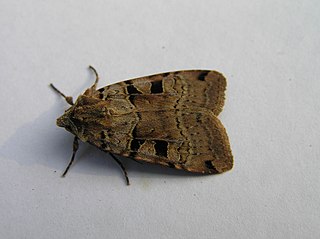Related Research Articles

The double square-spot is a moth of the family Noctuidae. It is distributed through most of Europe except Portugal, the Mediterranean islands and northernmost Fennoscandia. In the East, the species ranges East across the Palearctic to Siberia and in the South-East to the Black Sea and in Iran. It rises to a height of about 2000 metres in the Alps.

The bright-line brown-eye is a moth of the family Noctuidae. The species was first described by Carl Linnaeus in his 1758 10th edition of Systema Naturae. It is a common species throughout Europe, but is also found in North Africa, temperate North Asia and Central Asia, Asia Minor, Syria, and Turkestan, northern India, China, Korea and Japan.

Agrochola circellaris, The Brick, is a species of moth of the family Noctuidae. It is distributed throughout most of Europe, Asia Minor and Armenia.

Anaplectoides prasina is a species of moth of the family Noctuidae. It is found in both the Palearctic and Nearctic realms.

Eupselia satrapella is a species of moth of the family Depressariidae. It is found in Australia, where it has been recorded from Queensland, New South Wales and the Australian Capital Territory.

Mesapamea secalis, the common rustic, is a moth of the family Noctuidae. The species was first described by Carl Linnaeus in his 1758 10th edition of Systema Naturae. It is found in Europe, north-west Africa, Turkey and northern Iran.

Apamea lateritia, the scarce brindle, is a moth of the family Noctuidae. It is found in much of the Palearctic. It is a sporadic migrant in Great Britain, where it is recorded from the east and south-east coasts.
Ypsolopha delicatella is a moth of the family Ypsolophidae. It is known from the United States, including Arizona and California.
Ypsolopha nella is a moth of the family Ypsolophidae. It is known from the United States, including Arizona and Utah.
Sophronia primella is a moth of the family Gelechiidae. It was described by August Busck in 1907. It is found in North America, where it has been recorded Alabama, Illinois, Kansas, Oklahoma, Tennessee, Arizona and Colorado.
Gnorimoschema ericameriae is a moth in the family Gelechiidae. It was described by Keifer in 1933. It is found in North America, where it has been recorded from California.
Scrobipalpula ephoria is a moth in the family Gelechiidae. It was described by Edward Meyrick in 1917. It is found in Peru.
Scrobipalpula erigeronella is a moth in the family Gelechiidae. It was described by Annette Frances Braun in 1921. It is found in North America, where it has been recorded from Montana.
Scrobipalpula hemilitha is a moth in the family Gelechiidae. It was described by Clarke in 1965. It is found on the Galapagos Islands.
Battaristis ichnota is a moth of the family Gelechiidae. It was described by Edward Meyrick in 1914. It is found in Guyana.
Anacampsis kearfottella is a moth of the family Gelechiidae. It was described by August Busck in 1903. It is found in North America, where it has been recorded in Kentucky, Pennsylvania and New Jersey.
Monochroa angustipennella is a moth of the family Gelechiidae. It was described by James Brackenridge Clemens in 1863. It is found in North America, where it has been recorded from California, Illinois, Maine, New Jersey, New York, Ohio, Oklahoma and Pennsylvania.
Monochroa fragariae, the strawberry crown miner moth, is a moth of the family Gelechiidae. It was described by August Busck in 1919. It is found in North America, where it has been recorded from Oregon and British Columbia.
Pilostibes serpta is a moth in the family Xyloryctidae. It was described by Thomas Pennington Lucas in 1901. It is found in Australia, where it has been recorded from New South Wales, Queensland, South Australia and Western Australia.
Chlamydastis tryphon is a moth in the family Depressariidae. It was described by August Busck in 1920. It is found in Guatemala.
References
- ↑ "Scrobipalpula Povolný, 1964" at Markku Savela's Lepidoptera and Some Other Life Forms. Retrieved July 9, 2017.
- ↑ Moth Photographers Group at Mississippi State University
- ↑ Proceedings of the United States National Museum 27 (1375): 758
| This article on a moth of the genus Scrobipalpula is a stub. You can help Wikipedia by expanding it. |